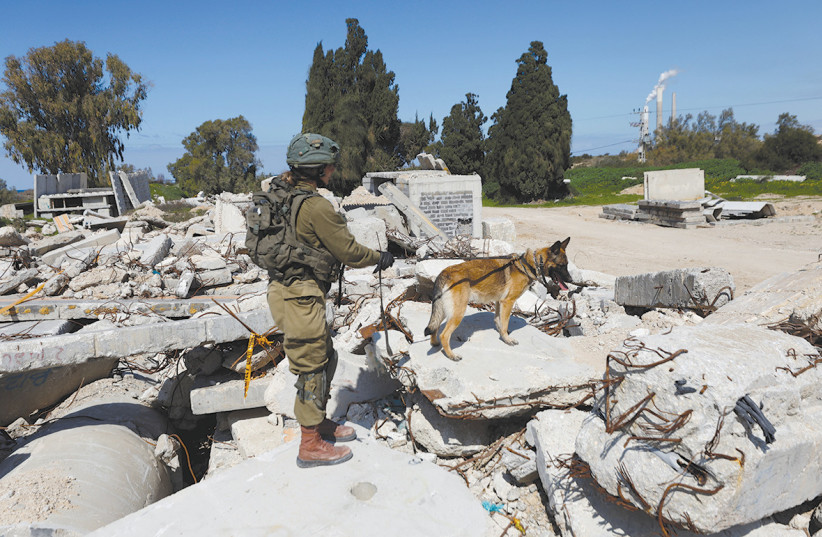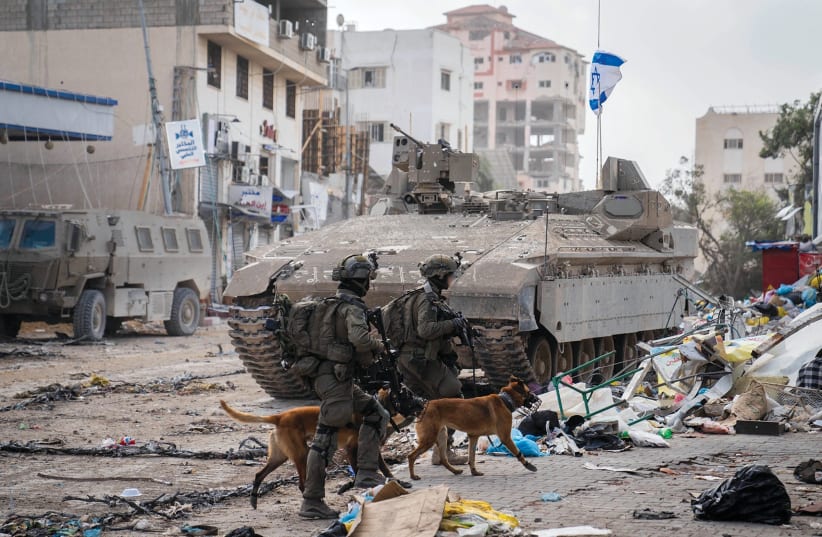
Four-legged members of the IDF’s Oketz (“sting”) Canine Unit have shown heroism under fire since the unit was formed in 1974.
On October 7, Oketz commander Lt.-Col. A awoke to the sound of sirens in his home in Rehovot. With his family in a safe room, he began to realize “something out of the ordinary” was happening, according to the daily Israel Hayom.
A called his platoon commanders, gathered them at their base, and with them and their canine comrades, headed south to the war. There, they hooked up with special forces commandos.
A formed three platoons, around 80 people, comprising his unit’s soldiers in training, and joined them and other Oketz soldiers in battle, together with naval commandos, Shaldag, Matkal, and other units.
Nero, a Belgian Malinois canine, joined the Naval Commando unit with his Oketz handler. He was sent in to comb a house on the Gaza border.


Nero found two terrorists hiding there. A burst of gunfire killed Nero. The Israeli commandos fired at the terrorists, brought in heavy equipment that collapsed the house on them, and killed them. Later, the commandos contacted A and said that Nero had saved their lives.
Roman emperor Nero fiddled while Rome burned. Oketz four-legged fighter Nero gave his life fighting terrorists who burned, murdered, raped, and pillaged. In the bitter war that followed October 7, many other Oketz canines saved lives – and gave their own in consequence.
Born out of failure
The Oketz canine unit has a long history.
Before the State of Israel was established, the Hagana formed a K-9 canine unit in 1939. The dogs were trained to attack machine gun nests, find the wounded, discover mines, and more. Their handlers even parachuted with their dogs, in training.
The unit was disbanded in 1954. Perhaps one reason was the bitter memories of Holocaust survivors, recalling Nazi soldiers unleashing their attack dogs.
In May 1974, terrorists from Lebanon barricaded themselves in the Netiv Meir Elementary School in Ma’alot, a small city in northern Israel, taking hostage more than 115 people, including 105 children. Most of them were 14- to 16-years-old from a high school in Safed on a pre-military Gadna field trip spending the night in Ma’alot.
Sayeret Matkal commandos stormed the building. In what ensued, the terrorists killed hostages with grenades and automatic weapons. Some 25 were killed, including 22 children, a bitter defeat.
It emerged that the Israeli forces had erred in identifying the floor on which the hostages were held and lost valuable time as a result.
Deep debrief of the disaster led to the formation of a canine unit, established by Yosi Labok, an expert dog trainer. The unit quickly proved itself in 1980, when on the night of April 7, Palestinian terrorists from Lebanon attacked border kibbutz Misgav Am and took hostage the children’s quarters, with kids aged one and a half to three.
At 10:00 p.m. on April 8, Sayeret Matkal commandos broke into the building through several openings in an attack that lasted only two minutes and released all the hostages. Oketz canines played key roles in identifying the terrorists’ locations. The Ma’alot disaster did not recur.
Training
Oketz dogs are highly trained, and each has a specialty.
The unit’s three companies are organized according to three missions: neutralizing terrorists in combat situations; detecting explosives; and search and rescue.
There is high demand to enlist in Oketz. Out of hundreds of volunteers, only 25 people are chosen annually.
Breeds
Oketz favors the Belgian Malinois.
For centuries, these dogs served Belgian shepherds. They were also used as a companion dog, detection dog, guard dog, guide dog, police dog, and search and rescue dog. They also served Belgian armed forces in both world wars, as well as the US Army.
Belgian Malinois are big, weighing 25 to 30 kgs. (55 to 66 pounds) – strong enough to tackle bad guys, but small enough to be lifted and carried by their handlers. They are smart, loyal, and powerful, with high endurance.
Some of the Oketz dogs are Sabras (Israeli born), and some are imported. They are checked weekly by a veterinarian to ensure they are in peak form.
Oketz dogs have at times been sent abroad to help in natural disasters, such as the 2010 earthquake in Haiti.
Friendly fire
As we have seen, not all Oketz tales of heroism have happy endings.
On December 15, Hamas hostages Yotam Haim, Samar Talalka, and Alon Lulu Shamriz were killed by mistake by friendly fire. Later, it emerged that on December 10, a dog from the Oketz unit had been sent into the building where the three hostages were being held. Hamas terrorists killed the dog, and were in turn killed by Golani soldiers, enabling the three hostages to escape.
The dog’s body camera captured the voice of Shamriz shouting “Help!” But the video from the camera was analyzed only later, after the dog’s body was recovered. After five days of flight, the hostages were shot by mistake.
After duty
What happens to veteran Oketz dogs that retire after years of service and heroism, usually at age seven or eight? Often, they join the families of their handlers and live the rest of their lives in serenity. Out of caution, however, they still wear muzzles in public.
The bond between dog and handler is ironclad. When an Oketz unit soldier was wounded in a military operation in Jenin, his dog refused to leave his side in the hospital.
Rest in peace
Many Oketz dogs have fallen in battle. They are buried with honors in a special cemetery at their base. A small memorial ceremony is held every August 30. Dogs that died in battle have “Fell in battle” written on their gravestones. Dogs that died of illness or old age have “Died while on active duty” inscribed on their headstones.
In the cemetery, there is a stone sculpture of an Oketz handler and his dog. It is based on Oscar, an Oketz dog killed in Hebron in 2003, whose body could not be recovered. On the monument are these engraved words, by J. Braverman:
Walk softly among these stones, for here lie heroes.
They carried no rifle nor wore a uniform
But always followed orders.
They went into battle with trust and love of duty.
Who among us can say we were better?
Walk softly, for here lie soldiers of Israel.
Is it ethical?
Is it morally justified to send dogs into battle, perhaps to die to save the lives of human soldiers?
Not everyone agrees. I found this, written anonymously, online: “I understand that using dogs like this does save our soldiers’ lives. But that doesn’t mean it is ethically acceptable. We, as a species, have convinced ourselves that we are a higher order and, as such, we can decide to do whatever we want with the rest of the natural world.”
For many dog lovers, including me, dogs are…well, people. Our family’s mixed-breed Yorkshire terrier Pixie, one-seventh the weight of an Oketz dog, brings us happiness every single day. And she never met a human she didn’t like. Visitors are greeted at our door with an explosion of barks, tail wags, and face licks.
But, I admit, on Passover she eats her chametz dog food.
Not, however, Oketz dogs.
The IDF Chief Rabbinate supplies special kosher for Passover food for the dogs. However, the food contains corn, which under Jewish Law is considered legumes (kitniyot), which is permitted to Sephardi Jews. I suppose Oketz dogs are Sephardim, right?
Post-traumatic stress
Writing in The Jerusalem Post, Andrea Samuels noted that not only do canines form an integral part of IDF’s special forces, but “they also help soldiers and veterans suffering from post-traumatic stress disorder (PTSD). These service dogs are trained by the Israel Guide Dog Center to help those suffering the devastating effects of trauma. Studies and reports from the center’s patients have shown how PTSD service dogs can significantly alleviate the suffering and frequency of trauma symptoms.”
Evolutionary biologists say that humans first domesticated dogs, from gray wolves, some 30,000 years ago. But I think they got it wrong. Dogs domesticated us. Dogs find meaning and happiness in their unconditional service to humans. We humans can learn much from them.■
The writer heads the Zvi Griliches Research Data Center at S. Neaman Institute, Technion. He blogs at www.timnovate.wordpress.com.
